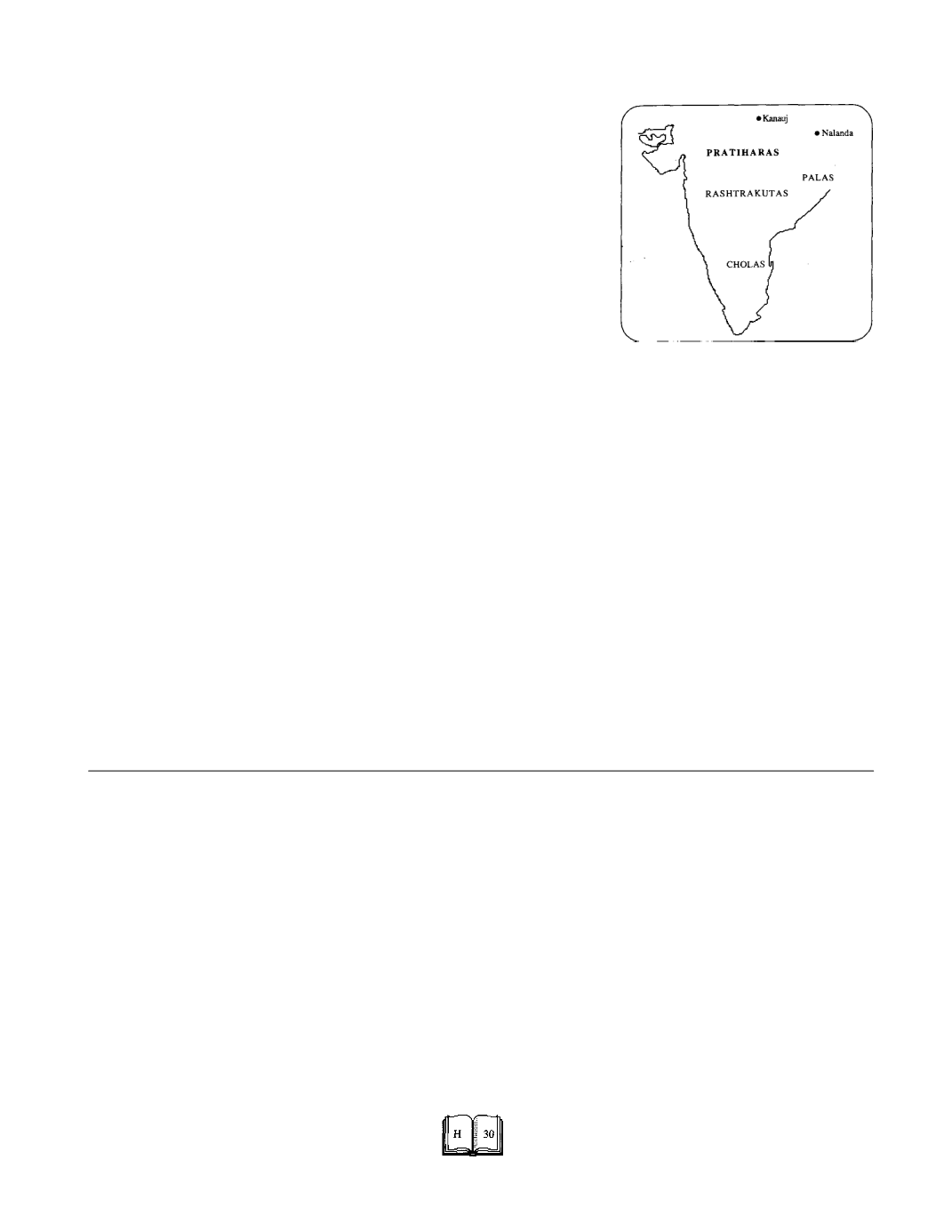

LURE - THRU THE AGES
E t e r n a l I n d i a
e n c y c l o p e d i a
THE PRATIHARAS 9th c. A.D.
Overview
After Harsha, the Gurjara-Pratiharas were
the foremost Hindu power in North India, be-
fore the Muslim conquest. Their empire at its
height extended from the Punjab to Central
India and from Kathiawad to Bengal. They
defended North India against the Arabs. Su-
laiman, visited Bhoja's court and praised his
cavalry and his administration.They fought
with the Palas and the Rashtrakutas for the
control of Kanauj.
The Pratihara dynasty was established in
the city of Mahodaya (Kanauj) at the end of
the 9th century.
778-805
A.D.
805-839
A.D.
836-885
A.D.
839-842
A.D.
885-910
A.D.
911-944
A.D.
Nagabhatta I
was the founder of the
Pratihara dynasty in the middle of the eight
century A.D. He did much to rehabilitate the
power of the Gurjaras which was threatened
by Arabs, Chalukyas and Rashtrakutas from
Sind, and Deccan. Extended the territories
upto Bengal, but he was driven back by the
Rashtrakuta king Dhruva of Deccan.
Vatsaraja (778-805)
was an ambitious
king; his ambition was to become overlord of
the whole of North India. He forced
Indhrayudh, ruler of Kanaju, into submission
and accept his overlordship. Vatsaraja
“forcibly wrested the empire in battle from
the famous Bhandi clan hard to overcome by
reason of the rampart made of their infuriated
elephants.”
Nagabhatta II (805-839)
is credited
with having extended his influence from Sind
in the north to Andhra in the south, and
Anartta on the Kathiawar to the border of
East Bengal. His achievement was the defeat
of Dharmapala, king of Bengal and the
expulsion of his protege Chakrayudha from
Kanauj. He himself sustained defeats at the
hands of the Rashtrakutas.
Ranabhadra (839-842),
was a weak
ruler and his short rule was full of trouble
with his enemies. He ruled only for three
years. The eastern parts of Ranabhadra’s
empire and Monghyr were disturbed by the.
haughty and cruel commanders of Devapala
of Bengal.
Bhoja I,
the grandson of Nagabhata II,
extended his power northwards, to the Punjab
and southwards as far as the Vindhyas, but
his further progress was stopped by Sankar-
avarman of Kashmir and Dhruva Dharava-
rsha, a Rashtrakuta chieftain of Broach.
Mihirbhoja
(836-885), the glorious chap-
ter of Pratiharas, began with his reign. Within
a few years he was able to consolidate his
position and his suzerainty was acknowl-
edged upto the foot of the Himalayas. King
Bhoja decided to measure swords with
Devapala of Bengal, it is alleged that De-
vapala “brought low the arrogance of the lord
of the Gurjaras.” After sometime King Bhoja
was able to gain success even against De-
vapala. The fact remains that King Bhoja got
the upper hand after the death of Devapala in
850 A.D.
Mahendrapala I (885-910),
son of
Bhoja, maintained his father’s empire and
extended it towards the east. His court was
adorned by the poet Rajasekhara. Mahendra
was followed by his sons Mahipala, Bhoja II
and Vinayakapala. Mahipala maintained his
hold on Saurashtra as late as 914 A.D. His
power was threatened by Indra III, the
Rashtrakuta king of the Deccan, who in-
flicted a severe defeat on him and took Kanauj.
Mahipala,
was ruling during the first
quarter of 11th c. A.D.; is referred to as the
overlord of Gauda in a record of 1026 A.D.
parts of Bengal had fallen into the hands of
the local dynasties.
Decline
The tripartite struggle weakened the Pra-
tiharas, the Palas and the Rashtrakutas. The
feudatories of the Pratiharas viz the Chandel-
las and Chedis became independent but their
most formidable enemy who weakened them,
most was Mahmud of Ghazni.
The Ghorids
1163-1206
They were originally Turkis and founded
the Turkish empire in India. The Ghorid em-
pire reached its zenith under two brothers
Ghiyas-ud-din Muhammad (1163-1203) and
Shihab-ud-din, also known as Muiz-ud-din
Muhammad Bin Sam or popularly called
Muhammedof Ghor seized Multan (1175),
conquered Uch (1178) seized Peshawar (1179),
Debal (1182), occupied the strategic fort of
Sialkot; Multan, Lahore and Sind became the
part of Ghorid empire; fought the battle of
Tarrain with Prithviraj (1190) but was de-
feated; again invaded and the Rajputs were
routed; the victory of Tarrain marked the
beginning of Turkish rule in India; Moham-
mad of Ghor died in 1206.
Senas
1184
The kingdom had its base in Bengal. It was founded
by Vijaya Sena, who came from Kamataka in the
Deccan.
Samantha Sena: He retained contact with his
southern compatriots. After him came Hemantha
Sena.
Vijaya Sena: Son of Hemantha Sena, he allied him-
self with the illustrious family of Senas and founded
the
independent sovereignty of his own dynasty. He laid
the foundation of the city of Vijayapura in West
Bengal.
Ballala Sena : Son of Vijaya Sena, he was the
founder of Kulinism, a system of nobility. He was the
author of two works
Danasagara
and the
Adbhuta
Sagara.
Lakshmana sena (1184) : He was a conquerer and
patron of learning. The most famous poet in his court
was Jaya Deva, the author of the
Gita Govinda.
Gahadavalas
1085-1194
After the fall of Pratiharas, the Gahadavalas came
to power in Kanauj, sometimes between 1080-85
A.D. They were connected with tfie Rashtrakutas or
Rathors. The founder of this dynasty was Chan-
dradeva.
Chandradeva (1085-1100) : Founder of the dy-
nasty. He defeated the Chandella general Kirtivar-
man. He was also responsible for checking the aggres-
sion of Vijayasena of Bengal.
Govindachandra (1114-1154): He was the grand-
son of Chandradeva. He also annexed some parts of
Magadha under the Pala monarchy. His minister La-
kshmidhara was the author of a book on law known as
Kritya Kalpataru.
Jayachandra (1170-1194) : He was the grandson
of Govindachandra. He was defeated and killed by
Muhammad Ghori.
Chronology
*
Vatsaraja
*
Nagabhatta II
*
Mihirbhoja
*
Ranabhadra
*
Mahendrapala I
*
Mahipala
















